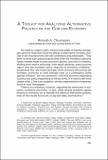| dc.contributor.author | Chumacero, Rómulo | |
| dc.coverage.spatial | CHILE | es_ES |
| dc.date.accessioned | 2019-11-01T00:02:44Z | |
| dc.date.available | 2019-11-01T00:02:44Z | |
| dc.date.issued | 2005 | |
| dc.identifier.isbn | 956-7421-21-8 | |
| dc.identifier.uri | https://hdl.handle.net/20.500.12580/3699 | |
| dc.description | As noted by Leeper (1995) “the business pages of leading newspapers give the impression that the effects of alternative monetary policies on the macroeconomy are well understood and predictable.” They tend “to write with great certainty that when the monetary authority raises interest rates it slows economic growth, and with it inflation, bidding down stocks and bonds. With equal certainty, press accounts report that the monetary policy responds to economic conditions.” Statements like “the recent strength of the economy will prompt the monetary authority to raise interest rates as a preemptive strike against inflation” are not uncommon. With the economy responding to policy and policy responding to the economy, it is hard to tell what causes what. Chile is no exception: similar statements are frequently found in local newspapers. | |
| dc.format | .pdf | |
| dc.format.extent | Sección o Parte de un Documento | |
| dc.format.medium | p. 261-302 | |
| dc.language.iso | eng | |
| dc.publisher | Banco Central de Chile | |
| dc.relation.ispartof | Series on Central Banking, Analysis, and Economic Policies, no. 9 | |
| dc.rights | Attribution-NonCommercial-NoDerivs 3.0 Chile | * |
| dc.rights.uri | http://creativecommons.org/licenses/by-nc-nd/3.0/cl/ | * |
| dc.subject | POLÍTICA MONETARIA | es_ES |
| dc.subject | MACROECONOMÍA | es_ES |
| dc.subject | TASAS DE INTERÉS | es_ES |
| dc.subject | DESARROLLO ECONÓMICO | es_ES |
| dc.title | A toolkit for analyzing alternative policies in the chilean economy | |
| dc.type.doc | Artículo | |
| dc.file.name | BCCh-sbc-v09-p261_302 | |


